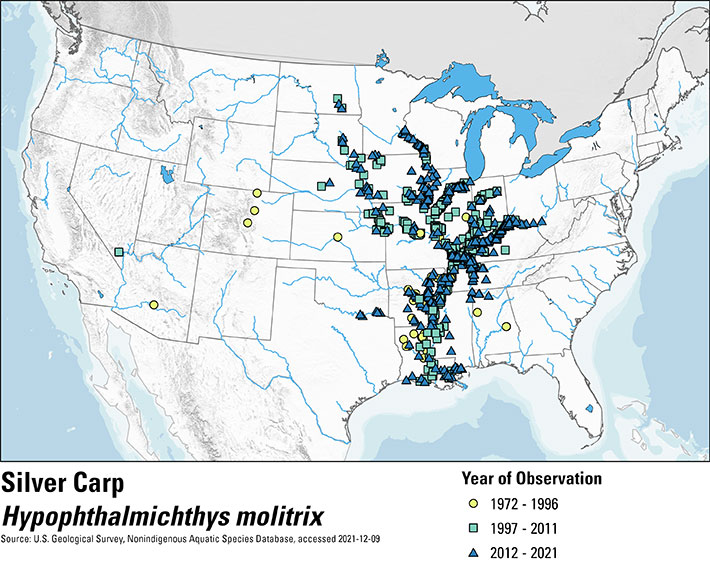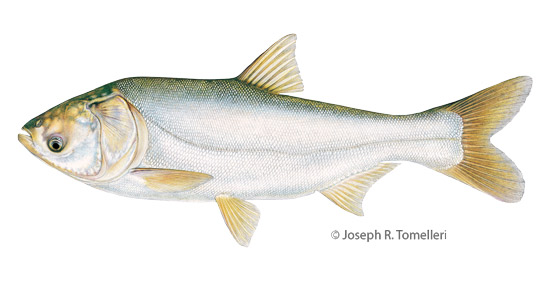Silver Carp
Hypophthalmichthys molitrix
Fast Facts
Silver carp can jump 9 feet or more out of the water when startled by boat engines. This poses a hazard for anglers, boaters and other recreational users. They are a schooling species and can be found grouped in large numbers.
Origin
Large rivers, canals and lakes in eastern Asia from southern Russia and North.
Diet
Phytoplankton
Life Span
15-20 years
Size
Maximum of more than 80 pounds and nearly 4 feet in length.
Historical Occurrence
 Historical occurrences of silver carp in the United States. Data from the U.S. Geological Survey Nonindigenous Aquatic Species database, December 2021, represent reported observations of silver carp, but populations may not be established in all mapped locations.
Historical occurrences of silver carp in the United States. Data from the U.S. Geological Survey Nonindigenous Aquatic Species database, December 2021, represent reported observations of silver carp, but populations may not be established in all mapped locations.
See current silver carp occurrence data on the U.S. Geological Survey NAS database »

Background
Silver carp were first imported into the U.S. in the early 1970s to control phytoplankton (microscopic marine algae) blooms in sewage lagoons and as a potential addition to fish production ponds. By 1975, silver carp had been captured from the Bayou Meto and the White and Arkansas rivers and by 1981, from the White, Arkansas and Mississippi rivers in Arkansas.
Silver carp are now well established throughout much of the Mississippi River basin and are expanding in the Ohio River and other basins. In addition to concerns over ecological and related economic impacts, silver carp pose an additional threat to human safety as they regularly jump out of the water when disturbed, particularly in response to outboard motors. Silver carp was listed as “injurious” under the Lacey Act in 2007.
Physical Description
Silver carp are deep-bodied, or wide, with a moderately large and broad head encompassing just under one third of their body size. They have a toothless upturned lower jaw and eyes are located below the axis of the body. Their body is silver with a slate gray head and dorsal surface and white belly with a keel extending from the anal fin to the throat. Silver carps are closely related to bighead carps and have been known to hybridize (cross-breed) with that species and produce viable, reproductive offspring.
Preferred Habitat
Silver carp prefer habitats in the standing waters of rivers, canals and lakes, tolerating water temperatures from 43 to 82° Fahrenheit.
Diet
Silver carp feed primarily on phytoplankton and can out-compete many native fish juveniles. They can efficiently strain suspended material from the water with specialized gill rakers that resemble sponge-like plates. Like the bighead carp, silver carp lack a true stomach which requires them to feed almost continuously.
Size
Silver carp mature in 2 to 4 years and commonly weigh 20 pounds. When older, they can reach a maximum size of more than 80 pounds.
